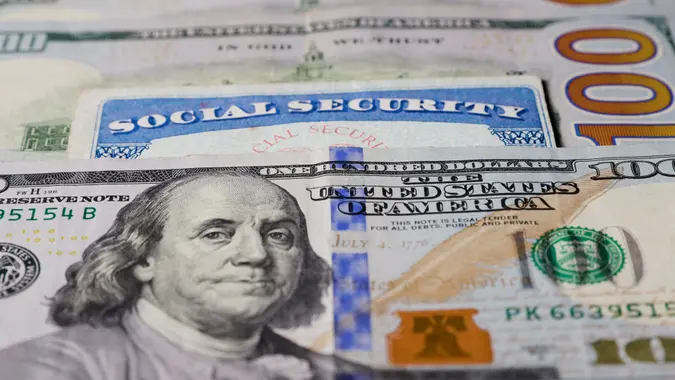401(k) Hardship Withdrawals: What You Need to Know

Commitment to Our Readers
GOBankingRates' editorial team is committed to bringing you unbiased reviews and information. We use data-driven methodologies to evaluate financial products and services - our reviews and ratings are not influenced by advertisers. You can read more about our editorial guidelines and our products and services review methodology.

20 Years
Helping You Live Richer

Reviewed
by Experts

Trusted by
Millions of Readers
A 401(k) hardship withdrawal is the process of accessing funds in your workplace 401(k) account before the retirement age of 59 ½.
Typically, there are penalties for withdrawing funds before retirement age. But a hardship withdrawal allows you to access the funds in your retirement accounts without paying the penalties.
Qualifying Expenses for a Hardship Withdrawal
It’s up to your 401(k) provider to decide what is a qualifying expense. Common qualifying common expense include:
- Medical bills for you, your spouse or dependents
- Costs to prevent foreclosure or eviction from your primary residence
- Funeral expenses for a family member
- Down payment on a primary home (not investment properties)
- College tuition and related fees for yourself or a family member
- Repair costs for damages to your home due to natural disasters (if FEMA declares it a disaster area)
Expenses That Usually Don’t Qualify
The following don’t typically qualify for a hardship withdrawal:
- Paying off credit card debt
- Buying a car
- Investing in real estate
- Covering everyday expenses like rent or groceries
How to Qualify for a 401(k) Hardship Withdrawal
Before you can withdraw money from your 401(k) for a hardship, you must meet your employer’s eligibility requirements and prove that you have a legitimate financial need.
Step 1: Check Your Employer’s 401(k) Plan
Not all 401(k) plans allow hardship withdrawals. Your employer’s plan administrator can tell you if this option is available and what requirements you must meet.
Step 2: Prove Financial Hardship
You’ll need to exhaust other avenues of financial aid, including nontaxable distributions from other retirement accounts, insurance payouts, plan loans or other access to funds.
You may need to provide documentation showing that you meet the IRS qualifications. This could include:
- Medical bills showing unpaid balances
- Eviction or foreclosure notices from your landlord or mortgage lender
- College tuition invoices with upcoming due dates
Each plan has different documentation requirements, so check with your HR or benefits department.
How Long Does It Take to Get a Hardship Withdrawal?
Most withdrawals take 7 to 14 business days to process once approved, but the timeline depends on your employer and plan provider.
Amount You Can Withdraw
The IRS has several rules around how much money you can withdraw:
- You can only withdraw the exact dollar amount you need
- You can’t access any money you earned from your investments. Only what you and your company contributed to the account.
For example, if you and your employer have contributed $50,000 to your 401(k) account, but your total balance is currently $100,000, you are only allowed to access up to $50,000 from that account.
What Are the Costs?
There are a few costs you might have to pay for a hardship withdrawal:
- Your 401(k) custodian might charge a fee for the withdrawal.
- You haven’t paid income taxes on your contributions yet. They will be due the next time you file taxes for the year.
- If your expense doesn’t meet the IRS’s definition of a hardship, you will also have to pay a 10% early withdrawal penalty.
Can You Avoid the 10% Early Withdrawal Penalty?
Some hardship withdrawals may be exempt from the 10% penalty, including:
- Medical expenses that exceed 7.5% of your adjusted gross income (AGI)
- Permanent disability
- Certain disaster-related expenses
There are several other exceptions for very specific circumstances, which can be found on the IRS website.
Alternatives to a 401(k) Hardship Withdrawal
A 401(k) hardship withdrawal should be a last resort for trying to access funds during a financial emergency. Not only are there taxes (and possible penalties) assessed on your withdrawal, but you also can’t put that money back. That means you’ll have less in your retirement account going forward, missing out on potential tax-free growth.
Here are a few alternatives to consider before raiding your 401(k) account:
1. 401(k) Loan
- You borrow from your 401(k) but must repay it with interest.
- No taxes or penalties unless you fail to repay it.
2. Home Equity Loan or HELOC
- Borrow against your home’s value.
- Lower interest rates than credit cards or personal loans.
3. Personal Loan
- No tax penalties, but higher interest rates apply.
- Faster approval process than a hardship withdrawal.
4. Emergency Savings
- Ideally, you’d use an emergency fund before tapping retirement savings.
If you don’t have a backup fund, consider starting one now to avoid hardship withdrawals in the future.
Should You Take a 401(k) Hardship Withdrawal?
A 401(k) hardship withdrawal should be your last resort when facing a financial crisis. While it offers immediate cash relief, it also reduces your retirement savings and could come with tax penalties.
Before withdrawing, explore other options, like a 401(k) loan, emergency savings or alternative financing. If you do need to withdraw, work with your employer’s plan administrator to ensure you meet all requirements and minimize penalties.
Your retirement savings should be protected as much as possible — so think carefully before making a move that could impact your financial future.
If you’re unsure whether a 401(k) hardship withdrawal is the right move, consult a financial advisor to explore all your options before making a decision.
FAQs About 401(k) Hardship Withdrawals
It's only natural to have some questions when it comes to something as important as retirement. With that in mind, here are some freqnetly asked questions when it comes to hardship withdrawals.- What qualifies for a 401(k) hardship withdrawal?
- According to the IRS, to qualify for a 401(k) hardship withdrawal, you need to show an immediate and heavy financial need. This definition is subjective, and ultimately, it's up to your 401(k) plan custodian to approve your request.
- There are a few circumstances that automatically meet the definition of an immediate and heavy financial need, including medical care expenses, funeral expenses, first-time homebuyer expenses (up to $10,000), payments to avoid foreclosure or eviction from principal residence, and more.
- Can I take a 401(k) hardship withdrawal to pay off credit card debt?
- If your plan administrator allows it. You will need to prove that your debt is causing an immediate and heavy financial need and that you have exhausted all other sources of funding. But in many cases, this may not qualify for a hardship withdrawal.
- Plus, you're usually better off finding a 0% interest credit card and doing a balance transfer to avoid high interest rates.
- How can I prove hardship for a 401(k) withdrawal?
- You first need to tell your 401(k) plan administrator about your immediate and heavy financial need. This may require submitting documentation of financial hardship or other proof that you need access to your 401(k) funds early.
- Plus, you may need to submit proof that you've exhausted other avenues of funding, such as loans, liquidating assets, or nontaxable distributions from other plans.
- How do I avoid a 20% tax on my 401(k) withdrawal?
- If you're withdrawing funds from your traditional 401(k) account, you typically will be on the hook for income taxes owed. And if you're taking an early withdrawal, you may also be assessed an additional 10% IRS penalty tax.
- To avoid this extra 10% tax, you'll need to make sure your distribution is eligible, such as being used for a first-time homebuyer down payment, medical expenses or qualified higher education expenses. But you'll still owe ordinary income tax on any traditional 401(k) withdrawal. To lower the tax owed, it's best to work with a licensed tax professional to help prepare your return.
Editorial Note: This content is not provided by any entity covered in this article. Any opinions, analyses, reviews, ratings or recommendations expressed in this article are those of the author alone and have not been reviewed, approved or otherwise endorsed by any entity named in this article.
Our in-house research team and on-site financial experts work together to create content that’s accurate, impartial, and up to date. We fact-check every single statistic, quote and fact using trusted primary resources to make sure the information we provide is correct. You can learn more about GOBankingRates’ processes and standards in our editorial policy.
- IRS. 2024. "Retirement Topics - Hardship Distributions."
- IRS. 2024. "401(k) Plan Hardship Distributions - Consider the Consequences."
- IRS. 2023. "Retirement topics: Exceptions to tax on early distributions."
- IRS. 2024. "Retirement Topics - Plan Loans."
- IRS. 2024. "Topic no. 557, Additional tax on early distributions from traditional and Roth IRAs."
- IRS. 2024. "401k Plans"
 Written by
Written by  Edited by
Edited by 

























